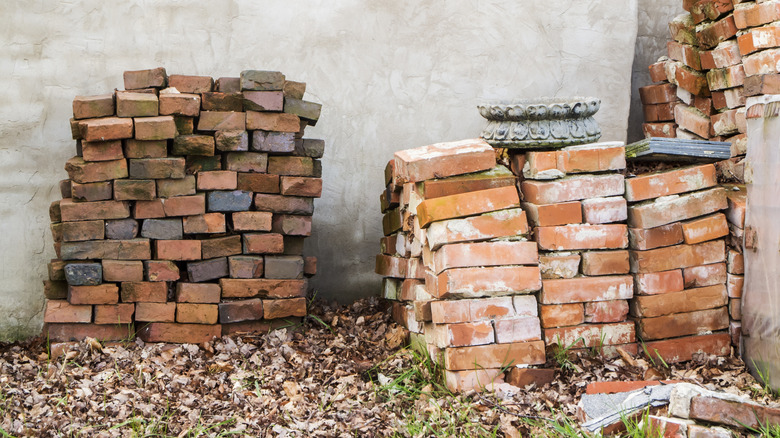Reuse Old Brick To Make A Super Functional DIY Compost Bin
Composting is one of the best things you can do for your garden, as well as the planet. Not only does it reduce waste, it puts that waste to good use, replenishing your garden's soil with rich nutrients. Composting is also highly customizable — anyone can find a way to compost that works for their lifestyle. You can spend a small fortune on an elaborate composting system, or you can DIY a compost bin from upcycled materials and never spend a dime. Since the whole point of composting is to recycle waste, an upcycled composting bin makes sense, and you only need one thing for this simple DIY: leftover bricks.
The idea for this compost bin comes from a simple fire pit structure made from upcycled common bricks. By layering up old bricks to form a frame with an opening in the middle, you'll create a strong and sturdy container for your compost. Your brick outdoor compost bin can be completely customized to your preferences (and easily altered as needs evolve), and it's perfect for renters since it is freestanding and removable. Plus, it's free of plastic, and the layered bricks provide natural ventilation to aerate the heap.
How to build your own brick compost bin
Before you get building, take stock of your materials and decide how wide to make your bin. It can be as small as five bricks laid flat to form a small circle, or as large as you wish. A bin lower to the ground will likely be more stable and the heap will be easier to manipulate. If you only have a limited number of bricks at your disposal, calculate how wide you can make your bin, adjusting the number of bricks in each layer until you land on your desired diameter and height. Then, get layering.
Place your bricks in a circle on the ground to let the compost mix in with the soil below and draw up helpful critters like earthworms to aid in the decomposition process. Situate the next layer of bricks on top, resting each brick in the middle of the joint below, creating a half running bond–type pattern. Continue until your bin is to your desired height. This sturdy brick pattern should hold up well to weather without mortar.
Due to the design of this bin, you'll need to be strategic in layering your compost, as it will be difficult (or even impossible) to turn. Start with a bottom layer of woodchips, brown leaves, or sticks to help with aeration. Add some layers of food scraps with cardboard or shredded paper on top of that, followed by the rest of your compost. You may want to consider a cover for your brick bin to keep out excess rainwater — an old plywood panel weighted with bricks or a tarp is a good option.
Customizing and troubleshooting your brick compost bin
Depending on your needs, your garden, and your preferences, you can customize your brick compost bin to make it work for you. If the ground is uneven, you may want to start with a brick base on top of the ground to keep it level. As you may have guessed, this bin will require deconstruction to access the fully composted material at the bottom of the heap. If the encased bin design isn't for you, consider building a three-sided, U-shaped brick compost structure. This is a popular design for concrete blocks, but it could also be done with common bricks if you have enough. It's also important to mention that the porous bricks will dry out your heap, so monitor your bin and add water occasionally to keep it moist.
Before you get building, keep in mind that there are some downsides to an outdoor compost bin that you might not have thought about. Many composters move their bins outdoors so they don't have to worry about odors, but the smell can still be a nuisance outside, especially if it attracts unwanted pests. A brick bin won't offer much by way of odor control, nor will it be a fail-safe against critters. One simple compost addition can help — try adding old herbs and spices to your backyard compost to mitigate odors and deter pests. Or, use your brick compost bin to make leaf mold instead (compost from leaves) by packing leaves into the bin. Just hose the leaves down occasionally to help with the decomposition process.


